A well-crafted trailer can make all the difference, turning a film from flop to blockbuster by strategically building excitement and emotional connection. Highlighting key characters, suspenseful visuals, and perfect timing can boost interest and viral sharing. Using audience reactions and social media metrics, studios refine their approach for bigger impact. Smart insights and data-driven tweaks further boost a film’s success. Stick around to discover how trailers truly can change a movie’s fate.
Key Takeaways
- High-quality, emotionally resonant trailers can boost audience interest and transform a film’s commercial prospects.
- Strategic content, including suspense and character reveals, can generate buzz and reframe a movie’s perception.
- Data-driven timing and targeted marketing optimize trailer impact, increasing opening weekend success.
- Viral challenges and social media engagement turn trailers into powerful promotional tools.
- Predictive analytics and audience feedback enable tailored trailers that significantly alter a film’s trajectory.
The Power of a First Impression: How Trailers Set the Stage
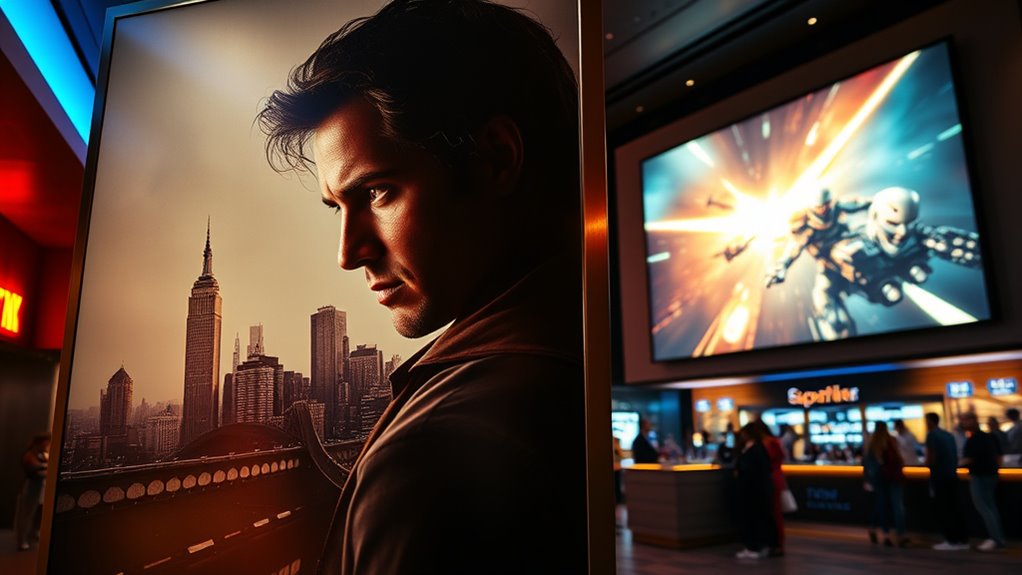
Trailers are often your first glimpse of a film, and they play a vital role in shaping your initial impression. When a trailer is high quality, it grabs your attention and makes you keen to see the movie. If it’s poorly made, it can turn you off even before the film hits theaters. Younger audiences, especially those aged 18-29, are particularly influenced by trailer quality when deciding what to watch. A strong trailer increases your likelihood of choosing to see the film, while a weak one might deter you. Trailers effectively create early interest and set expectations, directly impacting whether you’ll attend opening weekend. In essence, a well-crafted trailer can make or break a movie’s initial success by influencing your decision right from the start. Trailer quality significantly impacts viewers’ interest, making it a crucial element in marketing strategies. Additionally, film marketing techniques often focus heavily on the trailer’s effectiveness to maximize audience engagement. Furthermore, advancements in AI-powered marketing tools enable filmmakers to analyze viewer reactions and optimize trailers for even greater impact, emphasizing the importance of visual presentation in capturing audience attention.
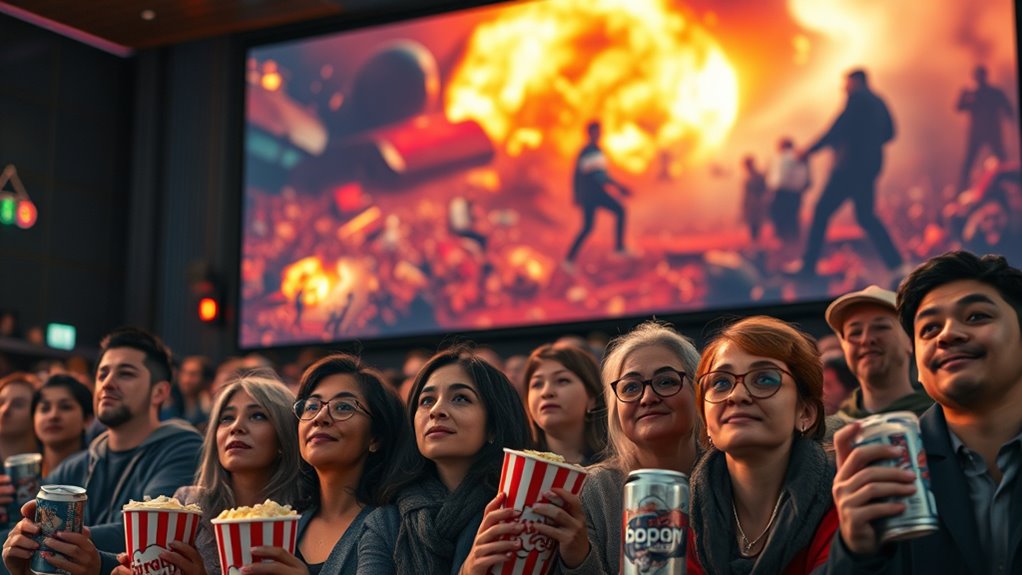
You can’t ignore the power of emotion when it comes to making a trailer go viral. When viewers feel positive emotions like joy or warmth, they’re more likely to share the trailer with others. That emotional connection is what turns a simple preview into a viral sensation. Emotional ads are 4 times more likely to be shared, demonstrating how powerful emotional engagement can be in driving sharing and viewership. Incorporating consistent messaging and authentic storytelling can further amplify this effect by creating a memorable and trustworthy brand impression. Additionally, tapping into energetic alignment can enhance the overall emotional impact, making the trailer resonate even more deeply with audiences. Recognizing relationship dynamics can aid creators in tailoring emotional cues to foster a stronger viewer response. Understanding personality traits can also help craft trailers that better connect with target demographics, increasing their virality potential. Moreover, leveraging visual aesthetics can amplify emotional appeal and make trailers more captivating, encouraging viewers to share their experience.
Emotional Resonance Boosts Engagement
Emotional resonance plays a crucial role in capturing your attention and boosting engagement with film trailers. When a trailer evokes strong emotions, it’s four times more likely to be shared, showing how deep emotional connections drive word-of-mouth. Smiling videos, which trigger positive feelings, are nearly five times more likely to hit over 10 million views on YouTube, demonstrating the viral power of happiness. Using smart product placement can triple emotional engagement, making the content more memorable. Technologies like facial recognition and skin conductance track real-time responses, revealing genuine emotional reactions that surpass traditional surveys. Research indicates that these insights help filmmakers fine-tune trailers to maximize emotional impact. Incorporating audience response tracking allows creators to identify which moments resonate most deeply, further enhancing emotional effectiveness. Additionally, emotional analytics can provide detailed data on viewer reactions, enabling more targeted and impactful trailer edits. For example, understanding individual emotional responses enables creators to tailor content that resonates on a personal level, increasing overall engagement. Ultimately, emotional resonance creates a lasting imprint, increasing anticipation and encouraging viewers to see the film, transforming passive viewers into active fans.
Positive Feelings Drive Sharing
Positive feelings are powerful drivers of sharing when it comes to movie trailers, as they create a memorable first impression that encourages viewers to pass them along. When your trailer evokes happiness or warmth, it taps into viewers’ emotions, making them more likely to share it with friends. Data shows that emotional ads are four times more likely to be shared than non-emotional ones, and videos that generate positive emotions like smiling can nearly reach five times the views on YouTube. Music, voiceovers, and smart product placements amplify these feelings, increasing engagement. Using real-time emotion tracking tools helps you understand what resonates. Biometric data, such as GSR, can provide objective insights into audience emotional responses in real-time. Additionally, aligning your trailer with spiritual energy can foster a deeper emotional connection with viewers, elevating their overall experience. Incorporating emotional engagement strategies, such as storytelling that evokes joy or nostalgia, can further enhance sharing potential. Ultimately, fostering positive emotions boosts sharing, broadening reach, and increasing the film’s chances of viral success and box office growth.
Case Study: When a Trailer Turned a Flop Into a Blockbuster
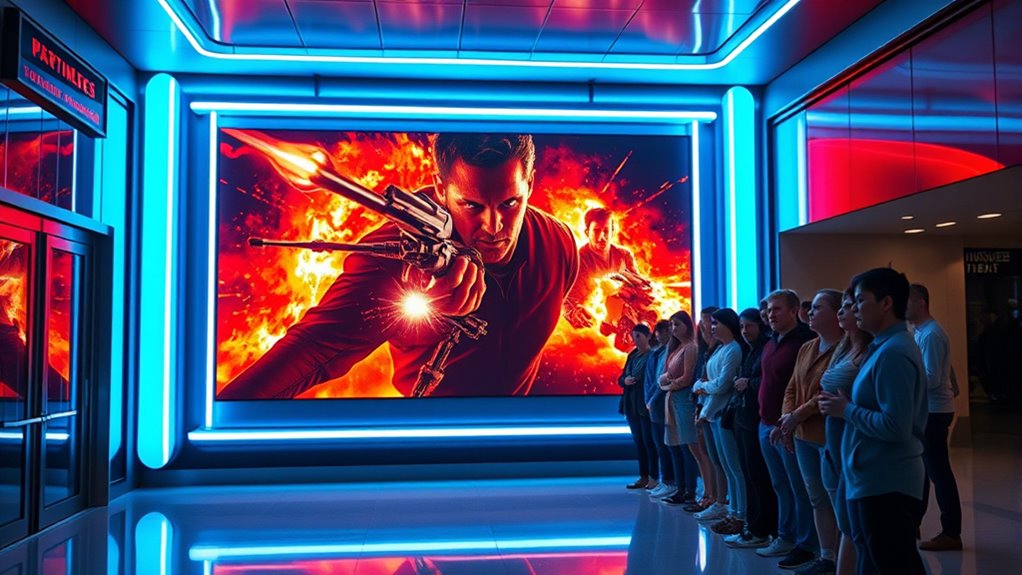
Sometimes, a single well-crafted trailer can completely change a film’s commercial fate, transforming a perceived failure into a box office hit. Take “Jumper,” for example. Despite low initial awareness, its trailer generated high engagement, sparking curiosity and interest. The trailer’s audiovisual elements evoked strong emotional responses, while star power and clear story motivation drew audiences in. Its success wasn’t accidental; it proved how a compelling trailer can:
- Boost theater attendance, even for underperformers
- Reframe a film’s appeal, highlighting its strengths
- Create social media buzz through shares and followers
- Leverage emotional content, pacing, and visual design effectively
- Trailer production techniques are often used by studios to predict a film’s future box office performance, emphasizing the importance of trailer quality in overall marketing strategy. Additionally, the impact of support hours can influence the timing of trailer releases and marketing campaigns to maximize reach and engagement. Effective trailer editing and visual storytelling are crucial components in capturing audience interest quickly and memorably. Recognizing the role of AI-powered data analytics in assessing trailer performance can help studios fine-tune their marketing efforts more precisely.
This shift demonstrates the power of strategic trailer content in changing a film’s trajectory, turning a flop into a blockbuster success.
The Art of Content Crafting: Balancing Reveal and Suspense
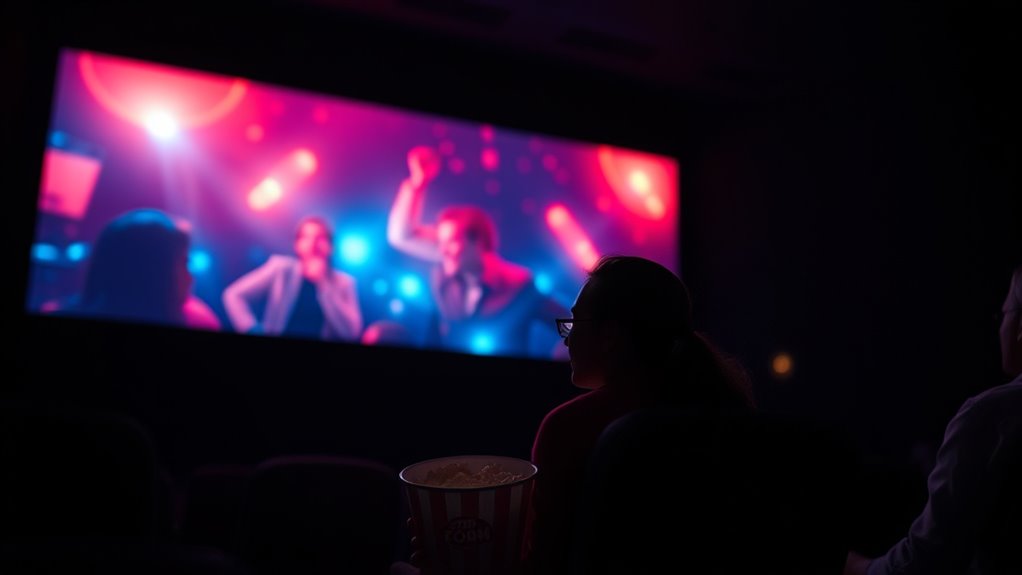
Crafting a trailer that captures audience attention requires a careful balance between revealing enough to intrigue viewers and withholding enough to maintain suspense. You want to showcase stunning visuals, iconic scenes, and mysterious narratives that spark curiosity. Simultaneously, strategic reveals and tension build-up keep viewers hooked without giving away the story. Sound design, music, and visual hints work together to evoke emotions and heighten anticipation. To illustrate, here’s how you might balance elements:
| Reveal Strategy | Suspense Techniques |
|---|---|
| Show key characters briefly | Use ambiguous plot hints |
| Highlight exciting moments | Incorporate cliffhangers |
| Share teasers, not full story | Employ pacing with fast and slow sequences |
This balance keeps audiences enthusiastic without spoiling the film’s surprises. Regular use of exfoliation techniques in editing can help in maintaining a dynamic flow that sustains curiosity.
Strategic Release Timing and Its Impact on Box Office Success
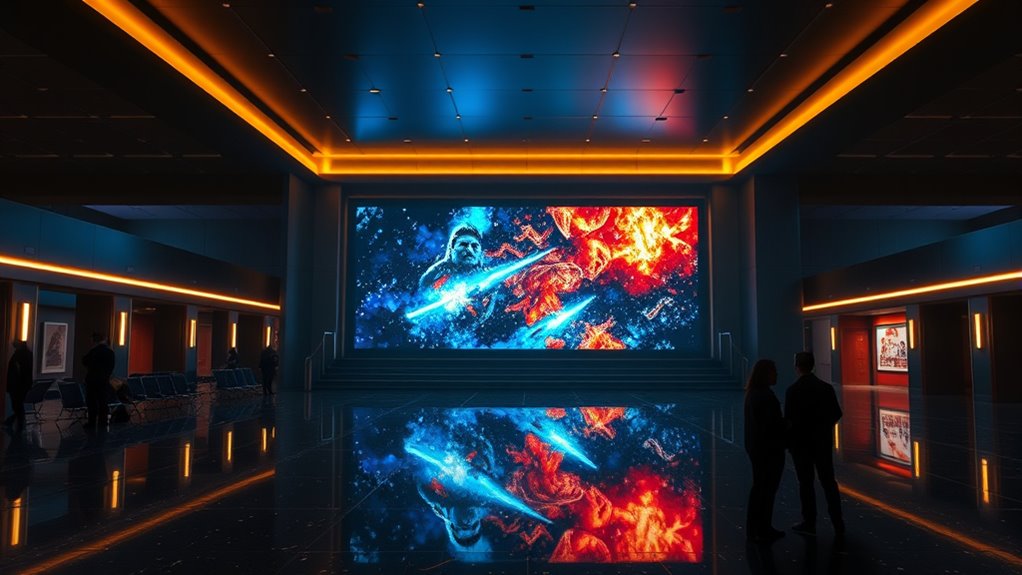
You can boost your film’s success by choosing the right release window, such as holidays or summer weekends, when audiences are most enthusiastic to see new movies. Timing also matters to avoid competing with major releases and to build anticipation through strategic trailer drops. When you align your release with audience demand and industry rhythms, you stand a better chance of maximizing box office results. Additionally, understanding the themed ambiance of your marketing campaign can help create a cohesive viewer experience that resonates and encourages word-of-mouth promotion. Being aware of market trends and insights can further refine your release timing by leveraging current audience interests and industry patterns. Incorporating innovative marketing strategies like augmented reality experiences or social media teasers can also amplify anticipation and engagement.
Optimal Release Windows
Strategic timing of a film’s release can considerably influence its box office performance. Choosing the right window helps maximize audience interest and revenue. To do this effectively, consider:
- Seasonal Strategy: Launch movies during peak demand times like summer or holidays to tap into larger audiences.
- Competitive Analysis: Avoid releasing alongside major competitors to reduce market saturation.
- Marketing Strategy: Sync promotional efforts with the release window to boost visibility and appeal.
- Data-Driven Decisions: Use analytics to identify *ideal* timing based on audience behavior and historical success patterns.
Timing and Audience Engagement
Timing plays a pivotal role in how audiences engage with movie trailers and, ultimately, influence box office results. Releasing a trailer at the right moment maximizes its impact, creating strong first impressions that shape viewers’ interest. Well-timed trailers can evoke emotional responses, boosting audience engagement and increasing the likelihood they’ll see the film. If released too early, interest may fade; too late, the buzz might not build enough. Strategic timing also provides a competitive advantage, helping your film stand out among others releasing simultaneously. Additionally, trailers that resonate with your target audience’s preferences generate more social media buzz and positive feedback. By aligning trailer releases with audience behavior and market trends, you considerably enhance your chances of driving box office success.
Leveraging Audience Reactions and Social Media Metrics
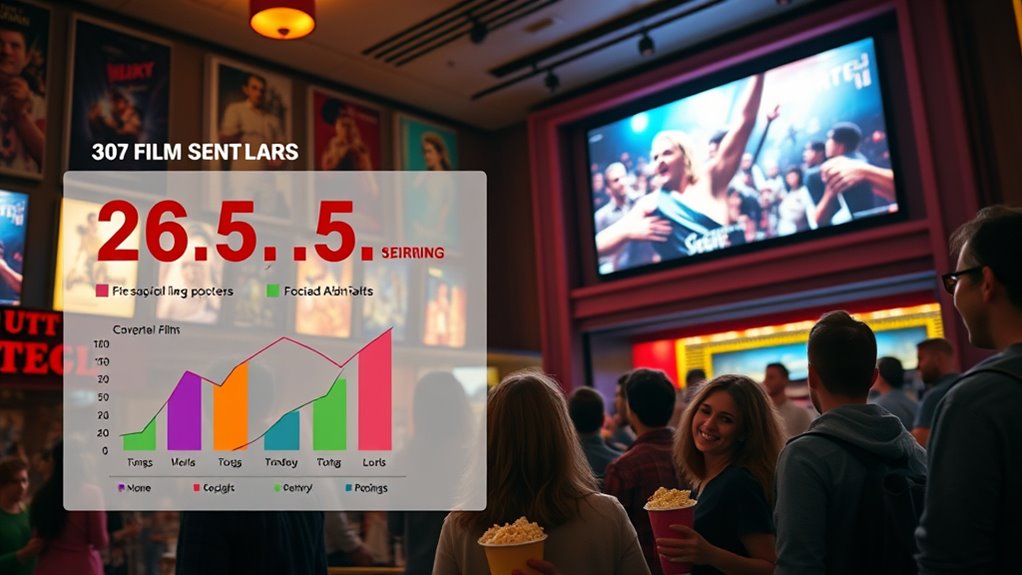
Leveraging audience reactions and social media metrics has become essential for shaping a film’s promotional success. You can gauge a trailer’s viral potential through likes and shares, which reflect audience interest. Comments offer direct insight into viewer opinions and community engagement, helping you understand emotional responses. Viral challenges, like the #InMyFeelingsChallenge, boost visibility by encouraging audience participation. User-generated content fosters personal investment, expanding the film’s reach organically. Tools like Infegy Atlas and Infegy Starscape track these interactions, providing valuable insights that inform marketing strategies.
Audience reactions and social media metrics are crucial for boosting a film’s promotional impact.
- Post volume measures buzz and audience interest.
- Engagement metrics quantify reactions like likes, shares, and comments.
- Anticipation emotion predicts sustained interest through emotional responses.
- Cross-cultural marketing targets diverse audiences for global success.
Predictive Insights: Using Data to Forecast a Film’s Turnaround
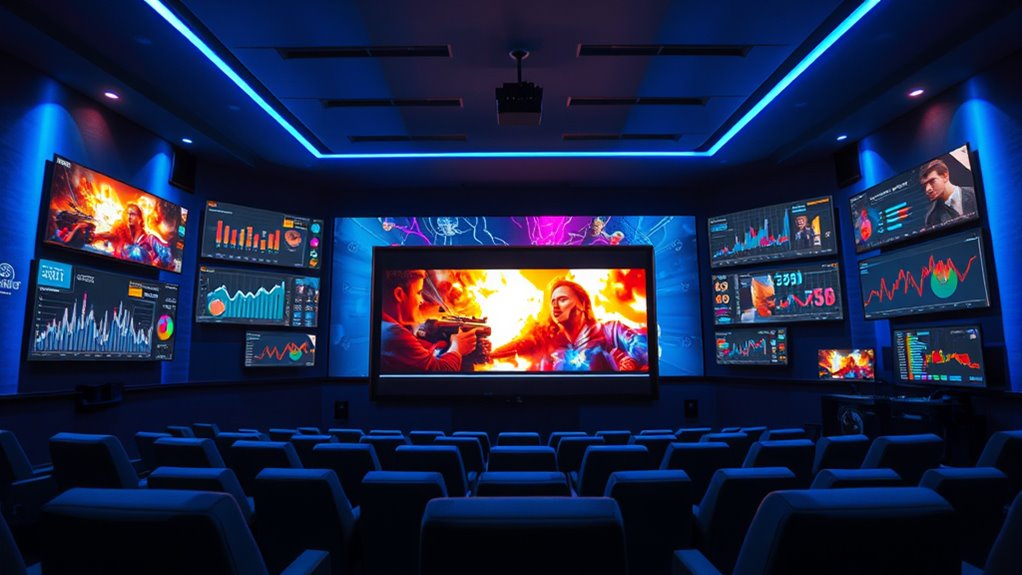
Predictive insights have revolutionized how studios forecast a film’s success by analyzing a wide range of data variables, such as genre, cast, director, and release date. You can leverage advanced statistical techniques and machine learning algorithms to predict box office performance more accurately. These models utilize historical data, including audience preferences and genre trends, to forecast a movie’s potential ROI. By examining factors like cast reputation, marketing budgets, and competition, studios can better strategize release timing and marketing efforts. Big data-driven models, including deep neural networks and network embeddings, uncover hidden patterns that influence success. Ultimately, this approach empowers you to make informed decisions on investment, distribution, and production, increasing the chances of turning a film’s fortunes around.
Frequently Asked Questions
How Do Trailers Influence Audience Anticipation Before a Film’s Release?
Trailers shape your anticipation by sparking excitement and curiosity through compelling visuals, music, and storytelling. When a trailer highlights strong narrative hooks or star power, it grabs your attention and makes you enthusiastic to see the film. Engaging trailers generate buzz on social media, boosting your desire to attend. Ultimately, well-crafted trailers turn your initial interest into strong anticipation, increasing the chances you’ll go to theaters when the film releases.
What Emotional Elements in Trailers Most Effectively Boost Viewer Interest?
You find that trailers boost viewer interest most when they evoke strong emotions like joy, hope, and suspense. Incorporate unexpected twists and suspenseful moments to capture attention, making viewers feel surprised and intrigued. Balancing positive emotions with moments of tension creates a dynamic experience, encouraging anticipation. When you evoke a mix of emotions—trust, excitement, nostalgia—you increase the chances viewers will want to see the full film and stay engaged.
Can Multiple Trailers Target Different Audience Segments Successfully?
You can successfully target different audience segments with multiple trailers by customizing content for each group. Focus on genre, characters, and themes that resonate with specific viewers. Personalize your trailers based on geographic, demographic, or interest-based factors. This approach increases relevance and engagement, making each trailer more effective in attracting diverse audiences. When done right, multiple tailored trailers boost anticipation, improve perception, and drive more viewers to watch the film.
How Does Trailer Timing Affect Its Ability to Generate Box Office Buzz?
Timing truly transforms trailer impact. If you release it too early, interest may dwindle, dulling excitement before the premiere. Wait too long, and anticipation might evaporate, losing momentum. The perfect timing builds buzz, boosts curiosity, and creates an engaging countdown. You want to strike a balance—synchronize trailer releases with marketing milestones—so your trailer triggers a tidal wave of talk and hype right at the peak of audience interest.
What Role Do Social Media Metrics Play in Predicting a Trailer’s Success?
You can see that social media metrics are essential for predicting a trailer’s success. By analyzing post volume, fan engagements, and sentiment, you get real-time insights into audience excitement and interest. High engagement and positive sentiment often indicate strong box office performance. Using platforms like TikTok, Twitter, and Instagram allows you to measure buzz, optimize marketing strategies, and identify potential flops early, reducing financial risks effectively.
Conclusion
Remember, a trailer is your film’s opening act—an invitation that can open hearts or close doors. When crafted with care and timing, it’s like casting a spell that turns a sleepy pebble into a roaring mountain. So, harness the power of emotional hooks and strategic releases. Your next trailer could be the spark that ignites a cinematic wildfire, transforming a flop into a legendary hit—proof that first impressions truly hold the magic.









